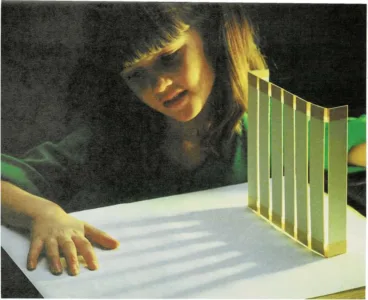
Light gets around
Materials
ball (small)
block (small)
cardboard
clay (modeling)
flashlight
jar (round)
masking tape
milk
mirror (small)
paper (white)
ruler
scissors
water
The instant you turn on a lamp, the room is bright. Light seems to be
everywhere at once. Light moves faster than anything we know of. It can
travel from the moon to the earth in less than a second!
Light moves in a straight line. But some things will make it bend. Some
things will block it. And some things will make it bounce back. Here’s a
project that will show you how light travels and how some things affect
it.
First, measure and cut eight strips of cardboard. These should be five
inches (20 centimeters) long and three-quarters of an inch (2 cm) wide.
Next, lay the strips out side by side, leaving a one-eighth inch (0.3
cm) space between the strips. Use the ruler to help you make the spaces
even.
Put something heavy across the strips to keep them in place, or have a
friend hold them down so they won’t slide apart. Tape the strips
together at the top and bottom. Then turn them over and tape the other
side. Trim off any extra tape from the ends. Bend the end strips back so
that the card will stand up.
With the card, and the other things you have collected, you are ready to
find out more about how light behaves. Take your things to a dark room.
Keeping it straight
Put the sheet of white paper on a table, or on the floor, and stand the
card on it. Hold the flashlight about four inches from the card and
shine it at the middle slit. Where does the light go?
Light shines through each slit in a straight beam. None of the beams
bend or touch each other. But each beam of light spreads a little as it
travels.
Getting together
Now fill the jar with water and place it on the other side of the card.
Shine the light through the slits into the jar. What happens to the
light now?
This time the light doesn’t spread! It comes together at one point on
the other side of the jar.
To see what is happening, add a few drops of milk—just enough to make
the water cloudy. Can you see the light beams? Where do they go?
The light beams bend toward each other when they enter the water. Then,
as they leave the water, they bend even more. They come together, or
focus, just outside the jar.
Nowhere to go
Place the block in back of the card, so that it touches the card. Shine
the light through the slits again. Which slits let the light through?
Where is the light stopped?
Do the same thing using the ball instead of the block. What happens?
The light is stopped wherever part of the block or the ball is in back
of the slits. Where nothing is in back of the slits, the light goes
through. The ball and the block are different shapes, so they stop the
beams of light in different places.

Bounce, bounce
Stand a small mirror on the other side of the card, about four inches
(10 cm) from it. Use a lump of clay to hold it in place. Make sure the
mirror is straight. Now shine the light through the slits. What happens?
Turn the mirror a little to one side. What happens to the light beams
this time?
When the light beams hit the mirror, they bounce back. If they hit the
mirror straight, they bounce back straight. But if they hit the mirror
at a slant, they bounce away from it at a slant.

